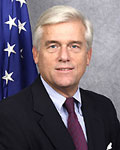 |
David L. Winstead has been commissioner of public buildings for the U.S. General Services Administration since October, 2005. During a break in a day-long GSA conference in Washington on federal courthouse design, Winstead sat down with ENR Washington Bureau Chief Tom Ichniowski. They discussed the agency’s Design Excellence program, courthouse construction and budget constraints.
The result [of Design Excellence] is appreciated. Look at the crowd…we’re still getting interest from the best architects and the best writers on architecture. They’re all here today. I do not see major changes in it. I think still the concepts of collaboration, the concepts of peer review, the concepts of making it as easy as possible for all kinds of firms—architects, engineers, designers—to be able to have an opportunity and a portfolio that would allow them to be able to bid on federal work, is still what we’re trying to enhance with Design Excellence. That’s the process that we look to.
No, we’re not. Flatly, no. We have the same resources [committed] to the Chief Architect’s office. We haven't reduced the number of positions. There’s always turnover. We just had a very good architect that’s just been offered to be chief architect at Cornell University. So we do lose people [to other organizations] but making sure we’re staffed out to handle all this work. We’ve got 12 courthouses in design and then another six in construction...so we have a lot of work. And it requires people.
I think the real challenge is making sure we manage the process to get as many people involved that can do business for us and qualify and to move it along as quickly as possible. I think we can do a little bit more to make sure that the process is as “outreaching” as possible. And to that end, making sure through peer review and through associations and groups of designers that we really reach out and we try to encourage and explain to them how they get engaged, how they can qualify and how they can be pre-selected to do work for GSA and the federal government. Whether its a courthouse or a border station or an office building or a lab for FDA. What we're trying to do is to make sure that the process is accessible and that we eliminate any kind of barriers that might dissuade people [because they feel] it takes too long or their firm’s so small they don't have the in-house capability to put a proposal together.
I do think times are different compared to the late 90s. The judicial budget was not under pressure. Congress was funding things more fully. We’ve obviously had the emergence of defense spenging and other things that have shrunk the overall federal budget. Our clients are trying to hold tight. They’re questioning our rent.... [In addition,] unfortunately in the last four or five years...material cost increases have been extreme, sometimes twice the CPI. In one case in the Los Angeles market, it is now close to three-to-four times [the CPI]. That’s created issues, because projects that have come through Design Excellence and go through the federal appropriations and authorization process, it does take longer. We cannot expend any money over $2.5 million without authority of Congress…[many projects today have] to be escalated or in some cases we have to go back [to Congress] and get reprogammed money….So that’s our real challenge
We’ve got a couple of courthouses…that are way beyond what we originally anticipated. Two are in the southern California market. Steel in L.A. went up 10 to 12%...in the past couple of years. There are other burdens now, but we seem to be managing them and will continue to. I think the role that we have is to work in partnership with the courts and our other clients and make sure that we understand their priorities, we understand their emergency needs in terms of courtroom space and how they rank their courthouses depending upon all those factors.

Post a comment to this article
Report Abusive Comment